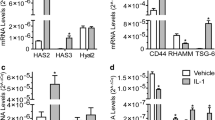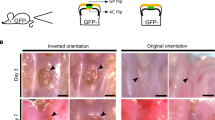Summary
Various cell lines of human synovial fibroblasts derived from synovium obtained at the time of biopsy or total joint-replacement surgery have been established. The synthesis of 3H-labelled hyaluronic acid (HA) in these cells has been determined, and the effects of adding HA of varying molecular size to the cultured cells examined. The results obtained clearly show that the in vitro synthesis of HA by these cells is influenced by the concentration and molecular weight (MW) of the HA in their extracellular environment. Synovial fibroblasts derived from an osteoarthritic joint demonstrated the most marked response on exposure to exogenous HA, showing a stimulation of HA synthesis with preparations of weight-average molecular weight (Mw)>5×105 in a concentration dependent manner. HA preparations with Mw<5×105 showed little or no effect except at high concentrations where a suppression of biosynthesis was observed. A model to explain these findings is proposed.
Similar content being viewed by others
References
Fraser JRE, Clarris BJ, Baxter E (1979) Patterns of induced variation in the morphology, hyaluronic acid secretion and lysosomal enzyme activity of cultured synovial cells. Ann Rheum Dis 38:287–294
Balazs EA, Watson D, Duff IF, Roseman S (1967) Hyaluronic acid in synovial fluid. I. Molecular parameters of hyaluronic acid in normal and arthritic human fluids. Arthritis Rheum 10:357–376
Balazs EA (1974) The physical properties of synovial fluid and the special role of hyaluronic acid. In: Helfet A (ed) Disorders of the knee. Lippincott, Philadelphia, pp 61–74
Cullis-Hill D, Ghosh P (in press) The role of hyaluronic acid in joint stability — a hypothesis for hip dysplasia and allied disorders. Med Hypotheses
Castor CW, Dorstewitz EL (1966) Abnormalities of connective tissue cells cultured from patients with rheumatoid arthritis. I. Relative unresponsiveness of rheumatoid synovial cells to hydrocortisone. J Lab Clin Med 68:300–313
Vuorio E (1977) Rheumatoid disease in cultured human synovial cells — a biochemical study on glycosaminoglycans, proteins and plasma membranes of synovial fibroblasts in culture. Scand J Clin Lab Invest 37 (suppl 149):1–72
Vuorio E, Einola S, Hakkarainen S, Penttinen R (1982) Synthesis of underpolymerised hyaluronic acid by fibroblasts cultured from rheumatoid and non-rheumatoid synovitis. Rheumatol Int 2:97–102
Dahl LB, Dahl IMS, Engstrom-Laurent A, Granath K (1985) Concentration and molecular weight of sodium hyaluronate in synovial fluid from patients with rheumatoid arthritis and other arthropathies. Ann Rheum Dis 44:817–822
Stephens RW, Sutherland J, Ghosh P, Taylor TKF (1976) Human serum and synovial fluid hyaluronidase — bovine testicular hyaluronidase is not a valid substitute in drug evaluation studies. Biochem Pharmacol 25:1507–1511
Kar NC, Cracchiolo A, Mirra J, Pearson CM (1976) Acid, neutral and alkaline hydrolases in arthritic synovium. Am J Clin Pathol 65:220–228
Greenwald RA, Moak SA (1986) Degradation of hyaluronic acid by polymorphonuclear leukocytes. Inflammation 10:15–30
Pigman W, Rizvi S, Holley HL (1961) Depolymerisation of hyaluronic acid by the ORD reaction. Arthritis Rheum 4:240–252
Matsumura G, Herp A, Pigman W (1966) Depolymerization of hyaluronic acid by autoxidants and radiations. Radiat Res 28:735–752
McCord JM (1974) Free radicals and inflammation: Protection of synovial fluid by superoxide dismutase. Science 185:529–531
Greenwald RA, Moy WW (1980) Effect of oxygen-derived free radicals on hyaluronic acid. Arthritis Rheum 23:455–463
McNeil JD, Wiebkin OW, Betts WH, Cleland, LG (1985) Depolymerisation products of hyaluronic acid after exposure to oxygen-derived free radicals. Ann Rheum Dis 44:780–789
Puig-Parellada P, Planas JM (1978) Synovial fluid degradation induced by free radicals. In vitro action of several free radical scavengers and anti-inflammatory drugs. Biochem Pharmacol 27:535–537
Simon RH, Scoggin CH, Patterson D (1981) Hydrogen peroxide causes the fatal injury to human fibroblasts exposed to oxygen radicals. J Biol Chem 256:7181–7186
Bates EJ, Lowther DA, Handley CJ (1984) Oxygen free-radicals mediate an inhibition of proteoglycan synthesis in cultured articular cartilage. Ann Rheum Dis 43:462–469
Bates EJ, Johnson CC, Lowther DA (1985) Inhibition of proteoglycan synthesis by hydrogen peroxide in cultured bovine articular cartilage. Biochim Biophys Acta 838:221–228
Bates EJ, Lowther DA, Johnson CC (1985) Hyaluronic acid synthesis in articular cartilage: An inhibition by hydrogen peroxide. Biochem Biophys Res Commun 132:714–720
Smith CA, Hamerman D (1969) Significance of persistent differences between normal and rheumatoid synovial membrane cells in culture. Arthritis Rheum 12:639–645
Marsh JM, Spencer S, Wiebkin O, Maini RN, Dumonde DC, Muir H (1974) Heterogeneity of human synovial tissue cultures. Ann Rheum Dis 33:578
Castor CW, Lewis RB (1976) Connective tissue activation X. Current studies of the process and its mediators. Scand J Rheumatol 5 (suppl 12):41–54
Smith CA, Hamerman D (1971) Properties of synovial cells in culture. J Exp Med 134:306–312
Castor CW, Dorstewitz EL, Rowe K, Ritchie JC (1971) Abnormalities of connective tissue cells cultured from patients with rheumatoid arthritis II. Defective regulation of hyaluronate and collagen formation. J Lab Clin Med 77:65–75
Castor CW, Smith SF, Ritchie JC, Dorstewitz EL (1971) Connective tissue activation II. Abnormalities of cultured rheumatoid synovial cells. Arthritis Rheum 14:55–66
Hamerman D, Smith C, Keiser HD, Craig R (1982) Glycosaminoglycans produced by human synovial cell cultures. Coll Rel Res 2:313–329
Dahl IMS, Husby G (1985) Hyaluronic acid production in vitro by synovial lining cells from normal and rheumatoid joints. Ann Rheum Dis 44:647–657
Barker SA, Bayyuk SHI, Brimacombe JS, Hawkins CF, Stacey M (1963) Fingerprinting the hyaluronic acid component of normal and pathological synovial fluids. Clin Chim Acta 8:902–909
Kofoed JA, Barcelo AC (1978) The synovial fluid hyaluronic acid in rheumatoid arthritis. Experentia 34:1545–1546
Balazs EA, Briller SO, Denlinger JL (1980) Na-hyaluronate molecular size variations in equine and human arthritic synovial fluids and the effect on phagocytic cells. Semin Arthritis Rheum 11 (suppl 1):141–143
Bjelle A, Andersson T, Granath K (1982) Molecular weight distribution of hyaluronic acid of human synovial fluid in rheumatic diseases. Scand J Rheumatol 12:133–138
Castor CW, Prince RK (1964) Modulation of the intrinsic viscosity of hyaluronic acid formed by human “fibroblasts” in vitro. The effects of hydrocortisone and colchicine. Biochim Biophys Acta 83:165–177
Saarni H, Tammi M, Vuorio E (1977) Effects of cortisol on glycosaminoglycans synthesized by normal and rheumatoid synovial fibroblasts in vitro. Scand J Rheumatol 6:222–224
Saarni H, Hopsu-Havu VK (1978) The decrease of hyaluronate synthesis by anti-inflammatory steroids in vitro. Br J Dermatol 98:445–449
Myers SL (1985) Suppression of hyaluronic acid synthesis in synovial organ cultures by corticosteroid suspensions. Arthritis Rheum 28:1275–1282
Kleesiek K, Greiling H (1982) Effect of anti-inflammatory agents on the glycosaminoglycan metabolism in cultured human synovial cells. Rheumatol Int 2:167–174
Verbruggen G, Veys EM (1977) Influence of sulphated glycosaminoglycans upon proteoglycan metabolism of the synovial lining cells. Acta Rheumatol 1:75–92
Smith MM, Ghosh P (1986) The effects of some polysulphated polysaccharides on hyaluronate (HA) synthesis by human synovial fibroblasts. Agents and Actions [Suppl] 18:55–62
Hamerman D, Wood DD (1984) Interleukin I enhances synovial cell hyaluronate synthesis. Proc Soc Exp Biol Med 177:205–210
Heino J (1986) Connective tissue components in synovial fibroblast cultures exposed to interleukin I and prostaglandin E2. Virchows Arch [Cell Pathol] 50:313–320
Peyron JG, Balazs EA (1974) Preliminary clinical assessment of Na-hyaluronate injection into human arthritic joints. Pathol Biol 22:731–736
Weiss C, Balazs EA, St Onge R, Denlinger JL (1980) Clinical studies of the intraarticular injection of Healon (sodium hyaluronate) in the treatment of osteoarthritis of human knees. Semin Arthritis Rheum 11 (suppl 1):143–144
Namiki O, Toyoshima H, Morisaki N (1982) Therapeutic effect of intra-articular injection of high molecular weight hyaluronic acid on osteoarthritis of the knee. Int J Clin Pharmacol Ther Toxicol 20:501–507
Kopp S, Wenneberg B, Haraldson T, Carlsson GE (1985) The short-term effect of intra-articular injections of sodium hyaluronate and corticosteroid on temporomandibular joint pain and dysfunction. J Oral Maxillofac Surg 43:429–435
Rydell NW, Butler J, Balazs EA (1970) Hyaluronic acid in synovial fluid. VI. Effect of intra-articular injection of hyaluronic acid on the clinical symptoms of arthritis in track horses. Acta Vet Scand 11:139–155
Rydell N, Balazs EA (1971) Effect of intra-articular injection of hyaluronic acid on the clinical symptoms of osteoarthritis and on granulation tissue formation. Clin Orthop 80:25–32
Asheim A, Lindblad G (1976) Intra-articular treatment of arthritis in race-horses with sodium hyaluronate. Acta Vet Scand 17:379–394
Auer TA, Fackelman GE, Gingerich DA, Fetter AW (1980) Effect of hyaluronic acid in naturally occurring and experimentally induced osteoarthritis. Am J Vet Res 41:568–574
Phillips MW (1980) Intra-articular sodium hyaluronate in the horse: A clinical trial. Proc 26th Ann Conv AAEP, pp 389–394
Gingerich DA, Auer JA, Fackelman GE (1981) Effect of exogenous hyaluronic acid on joint function in experimentally induced equine osteoarthritis: dosage titration studies. Res Vet Sci 30:192–197
Dayer J-M, Krane SM, Russell RGG, Robinson DR (1976) Production of collagenase and prostaglandins by isolated adherent rheumatoid synovial cells. Proc Natl Acad Sci USA 73:945–949
Burton K (1968) Determination of DNA concentration with diphenylamine. In: Colowick SP, Kaplan NO (eds) Methods in enzymology, part 12/1B. Academic Press, New York London, pp 163–166
Blumenkrantz N, Asboe-Hansen G (1973) New method for quantitative determination of uronic acids. Anal Biochem 54:484–489
Peterson GL (1977) A simplification of the protein assay method of Lowry et al. which is more generally applicable. Anal Biochem 83:346–356
Ohya T, Kaneko Y (1970) Novel hyaluronidase from streptomyces. Biochim Biophys Acta 98:607–609
Balazs EA, Darzynkiewicz Z (1973) The effect of hyaluronic acid on fibroblasts, mononuclear phagocytes and lymphocytes, In: Kulonen E, Pikkarainen J (eds) Biology of fibroblast. Academic Press, New York London, pp 237–252
Wiebkin OW, Muir H (1973) The inhibition of sulphate incorporation in isolated adult chondrocytes by hyaluronic acid. FEBS Lett 37:42–46
Wiebkin OW, Hardingham TE, Muir H (1975) Hyaluronic acid-proteoglycan interaction and the influence of hyaluronic acid on proteoglycan synthesis by chondrocytes from adult cartilage. In: Slavkin HC, Greulich RC (eds) Extracellular matrix influences on gene expression. Academic Press, New York London, pp 209–223
Wiebkin OW, Muir H (1975) Influence of the cells of the pericellular environment. The effect of hyaluronic acid on proteoglycan synthesis and secretion by chondrocytes of adult cartilage. Philos Trans R Soc Lond 271:283–291
Wiebkin OW, Muir H (1977) Synthesis of proteoglycans by suspension and monolayer cultures of adult chondrocytes and de novo cartilage nodules — the effect of hyaluronic acid. J Cell Sci 27:199–211
Toole BP (1973) Hyaluronate and hyaluronidase in morphogenesis and differentiation. Am Zool 13:1061–1065
Solursh M, Vaerewyck SA, Reiter RS (1974) Depression by hyaluronic acid of glycosaminoglycan synthesis by cultured chick embryo chondrocytes. Dev Biol 41:233–244
Handley CJ, Lowther DA (1978) Inhibition of proteoglycan biosynthesis by hyaluronic acid in chondrocytes in cell culture. Biochim Biophys Acta 444:69–74
Meier S, Hay ED (1974) Stimulation of extracellular matrix synthesis in the developing cornea by glycosaminoglycans. Proc Natl Acad Sci USA 71:2310–2313
Angello JC, Hauschka SD (1980) Hyaluronate-cell interaction. Effects of exogenous hyaluronate on muscle fibroblast cell surface composition. Exp Cell Res 125:389–400
Wigren A, Wik O (1974) The influence of hyaluronic acid on immobilized knees. An experimental study on adult rabbits. Ups J Med Sci [Suppl] 16:1–26
Weiner LB (1985) Applications of sodium hyaluronate in equine practice. Equine Vet Sci 5:210–216
Prehm P (1984) Hyaluronate is synthesized at plasma membranes. Biochem J 220:597–600
Underhill CB, Toole BP (1979) Binding of hyaluronate to the surface of cultured cells. J Cell Biol 82:475–484
Underhill CB, Toole BP (1980) Physical characteristics of hyaluronate binding to the surface of Simian Virus 40-transformed 3T3 cells. J Biol Chem 255:4544–4549
Underhill CB, Toole BP (1981) Receptors for hyaluronate on the surface of parent and virus-transformed cell lines. Binding and aggregation studies. Exp Cell Res 131:419–423
Laurent TC, Fraser JRE, Pertoft H, Smedsrod B (1986) Binding of hyaluronate and chondroitin sulfate to liver endothelial cells. Biochem J 234:653–658
Author information
Authors and Affiliations
Rights and permissions
About this article
Cite this article
Smith, M.M., Ghosh, P. The synthesis of hyaluronic acid by human synovial fibroblasts is influenced by the nature of the hyaluronate in the extracellular environment. Rheumatol Int 7, 113–122 (1987). https://doi.org/10.1007/BF00270463
Received:
Accepted:
Issue Date:
DOI: https://doi.org/10.1007/BF00270463




